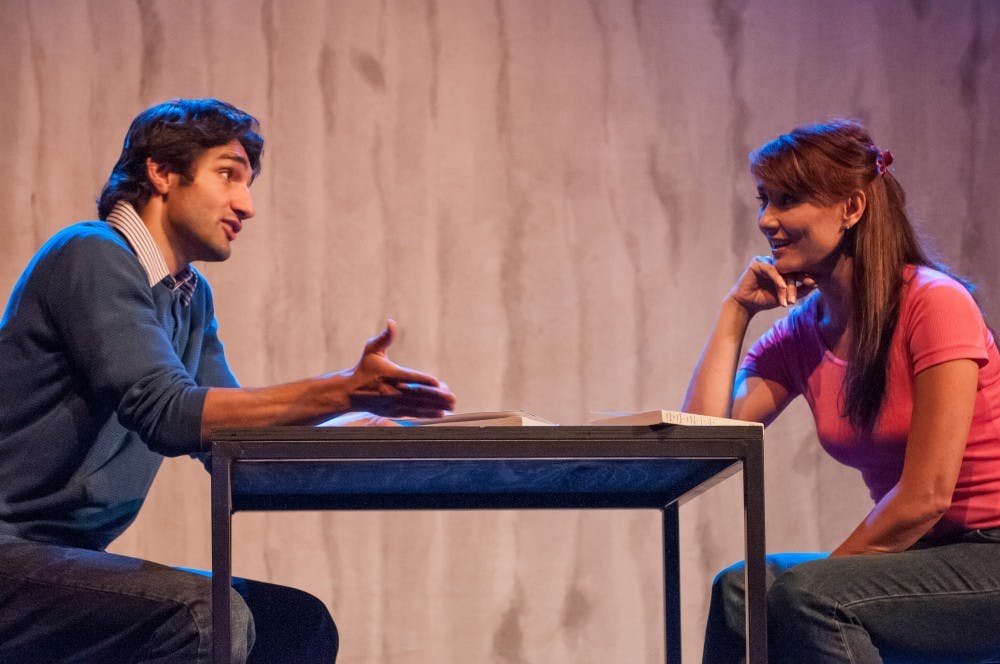gbgentz@unm.edu
“Paloma” is an extreme amount of talent contained in a very small space.
Firstly, Camino Real Productions, LLC is given intimate attention by its founder, Linda López McAlister. Since its birth in 2006, the company has taken its plays with small casts on tour to Mexico. The National Hispanic Cultural Center is its Albuquerque-based home, and the smaller venues help the company’s plays immensely.
Camino Real Productions is even coordinating with organizations such as the Center for Peace and Justice with a series of events. That alone is worth giving the plays your attention.
Playwright Anne García-Romero and director Gil Lazier each have a list of credentials longer than your arm. García-Romero has given direct attention to the world premiere of her piece “Paloma,” working with the actors and even sitting in the audience on opening night.
There are only three actors, each playing a central character and at least one other minor character. Twice, a parent of a central character is portrayed by the same actor who plays their child; it makes for fascinating theater.
At its core, “Paloma” is a love story. But “Paloma” also touches on topics such as religious conflict, coexistence and peace. They are noble ideas presented in cleverly poetic metaphors.
“Paloma” concerns two core relationships. One is the budding love affair of a moderate, practicing Muslim named Ibrahim, played by Abraham Jallad, and a casually practicing Catholic named, surprisingly enough, Paloma, played by Lena Armstrong. The lovers utilize an 11th century Arabic treatise of love called “Ring of the Dove” — paloma also being the Spanish word for dove — as their romantic doctrine, sharing passages aloud with one another. It’s remarkably touching.
The second relationship is between Ibrahim and his longtime friend, a young Jewish lawyer named Jared, played by Ron Weisberg.
Jared exists to fill out the threefold Abrahamic representation. It is a careful and intelligent choice when designing a show of this nature.
The central conflict between Ibrahim and Paloma is religious and sexual. Simply put, Paloma is a Latin fireball on a quest for coitus, but Ibrahim’s faith prevents him from anything beyond a good necking. Ibrahim is not bloodless by any means, and is certainly conflicted, so he constructs a journey to Grenada, Spain to find heaven on earth and enough gumption to take the plunge.
García-Romero defies the usual gender dynamic with a female pursuer and a reticent male, and it proves a good decision.
Get content from The Daily Lobo delivered to your inbox
As the two lovers travel through Spain, our three religions crop up again when they visit a historical building that started as a Muslim mosque, but was taken over by the Jews and then stripped and taken over by Christians. This unfortunately devalued history points to the potential for coexistence and harmony, while still pointing to the mass conflict and violent persecution. It provides metaphorical context for the problems of the lovers.
Jallad, Armstrong and Weisberg are exceptional and are pushed to many limits, especially Jallad, who practically never leaves the stage. Each brings energy, humor and zeal to a highly difficult piece.
“Paloma” is extremely cinematic in the sense that it is structured more like a movie than a play. It is split into 24 extremely short and often intense dialogues, each with radically different settings.
A projector informs the audience of the exact month, day and year, while the chairs and tables are rearranged. Unfortunately, the dates are largely confusing and hard to keep track of. There are just too many scenes. Really, the only specific date that truly matters is the traumatic and real-world event which makes up the Act 1 finisher. Perhaps a section of the program titling the scenes and dates for reference would help.
Each scene requires radically different set pieces, and while still quite cleverly minimalist, it takes up time. But the projections gives the audience something to look at while this is going on.
Further borrowing from film, the story is not quite nonlinear, but mostly alternates from the beginning of the story and then continues from about the middle, post-intermission climax. This allows the story to not only approach the pivotal tragedy, but also to address its aftereffects in similar breaths.
Although they are confusing, the dates do help convey the years that pass during the span of the play. It helps give weight to the characters you watch build, shatter, struggle and strive for recovery.






